CBS Library in the noughties
At the dawn of the millennium, CBS Library has only just moved into brand new premises in Solbjerg Plads, a building that was completed just as 1999 came to a close. Everything is new and ready for the new decade, which will see big changes to library operations. Lending is down whereas digital consumption is on the up, self-service is gaining ground and the library is experimenting with and developing new services for faculty. In 2005, René Steffensen is appointed new library director after Michael Cotta-Schønberg, a position he holds to this day.
In the noughties, the organizational structure of the library changes several times and the number of service points increases. Overall, collection maintenance, library space refurbishments, and orderliness are important parameters at this time. The library now boasts three service points, one even entirely void of books!
Porcelænshaven, where the Royal Porcelain Factory (now Royal Copenhagen) was once headquartered, now houses a new satellite library, completely free of books. Instead, students can access digital contents from dedicated terminals and get help with searching for information from on-site library staff. Whenever more in-depth help is required, a lecture room stands ready fully equipped with a brand new smartboard. At the end of the decade, the Porcelænshaven library is open 24/7 with a key card.
A lot of effort is going into the design of the new library building in Solbjerg Plads, and the library in Dalgas Have is refitted with new group rooms and individual study seats. Around this time, the library is slowly becoming a self-service library. New terminals are introduced for checking books in and out and students are required to find their own reservations on the hold shelves. More study seats are introduced as students increasingly demand places to study.
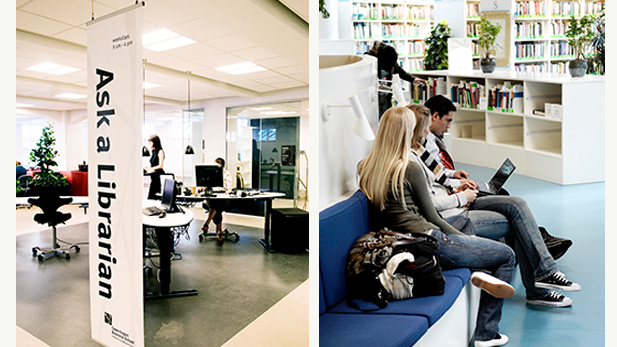
Photo: Jakob Boserup, the book-less library in Porcelænhaven and study spaces in Dalgas Have when the book collection was still in place and before study seats and group rooms took over.
A decision is made to merge the language and economy collections to create just a single space for print books in Solbjerg Plads. This is a direct consequence of the fact that lending, over a five-year period, has dropped by 42 %, whilst digital consumption has increased by 52 % in the same period. Despite the drop in lending, the library as a physical space remains popular.
At the beginning of the noughties, the number of visitors reaches one million and it becomes increasingly clear, especially with the new and central location on campus, that study facilities are an important part of the library service portfolio.
A work of art with great symbolism
At Solbjerg Plads, a very large work of art is suspended from the ceiling in the middle of the library. It is an enormous stabile designed by Danish artist Steffen Jørgensen (1940-2015). The work is labelled Desargues, which refers to Desargues' Theorem.
The sculpture depicts ten lines (steel pipes) that intersect at ten points. There are three points of intersection on each line, and three lines pass through each point of intersection. It is described by Michael Cotta-Schønberg, the former head librarian, as a distinctive symbol of a living, visible, and dynamic organization, and it serves as the inspiration for the CBS logo. In the image below the stabile remains to be suspended, and you can see the original interior that involves a very long counter.
a distinctive symbol of a living, visible, and dynamic organization.
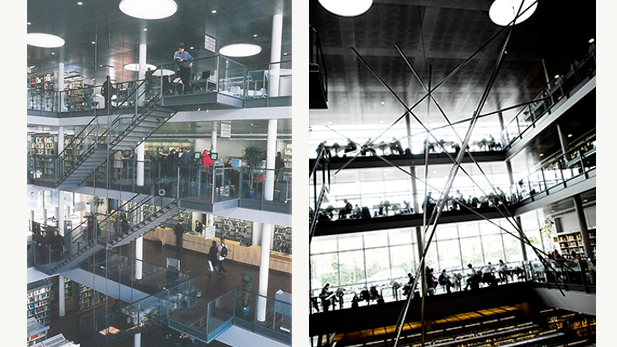
New and user-centric services
A whole suite of new services is born in the noughties. In 2003, an alumni scheme is launched to provide access for CBS alumni to a special alumni edition of the database Business Source Complete and free-of-charge home shipping of library content. Having materials shipped to a home address was never very popular with users whereas remote access to articles has been a great success from the get-go. The service still exists to this day.
In 2006, a chat service is introduced to make it easier to get help on weekdays between 1-4 PM. At this time, a teaching team is set up that is tasked with helping students and faculty improve their information literacy skills. The team defines five focus areas:
- teaching
- course readings (including e-compendia and cases)
- e-learning and tutorials
- communication
- online information.
Until now, teaching has been part of the liaison librarian portfolio but now the main focus is on embedding library teaching in the study programmes.
The liaison librarians on their part shift their primary focus to departments and faculty. Every CBS department and centre is assigned a dedicated liaison librarian as well as a subject librarian who can help with both teaching and procurement of books and other relevant materials.
At this time, there are ongoing discussions about the quality of our services and a number of quality-optimizing projects are initiated. 2004 sees the launch of the Book- a-Librarian service, which is directed at students who can now book an appointment with a librarian for help with search strategies and techniques, referencing, and much more when they embark on a written assignment. This service proves to be very popular indeed and exists to this day.
Another project, the MPP project, focuses on improving services for CBS researchers and is an attempt to develop new service models. The project runs for two years and involves the secondment of two members of staff to the Department of Management, Politics and Philosophy for 15 hours per week altogether. Classic services, including inter-library loans and instructional services, are also under review at this time.
A halfway evaluation suggests that a special focus on new PhD students is required. A decision is made to reach out early on in their employment with CBS with an offer of introduction to information retrieval, assistance in navigating the publishing process, and help with creating stable links to digital contents, a brand new invention at this time. The liaison librarian service is still very much alive.
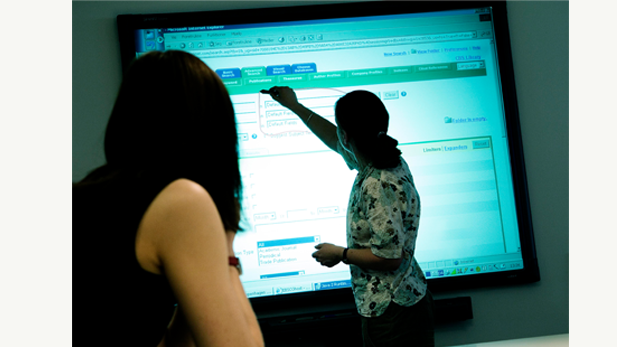
Six Sessions is the title of another project that is launched at this time. It is a series of short introductions to library databases and other services, at first targeting faculty in Porcelænshaven and undertaken in the brand new reading room that boasts a dedicated lecture theatre. All introductions are offered in English. This service has survived to this day, only now we send out invitations directly to all members of faculty, who in turn can sign up via an online calendar.
Advisory Board and strategic alliances
In the late 00s, there is an increased focus on internationalization. CBS researchers collaborate with colleagues around the world and for that reason 'the library needs to be internationally oriented, and we want to be able to contribute to CBS' international reputation' as René Steffensen, head librarian, explains in 2007.
At this time, CBS Library is a member of the Strategic Library Alliance, as is Baker Library at Harvard Business School. Mary Lee Kennedy, Executive Director at Baker Library, has a seat on the CBS Library advisory board alongside the dean of education, professors, student representatives, and the library management team. Early on the ambition is to make research available to everyone, and the purposes of the advisory board is to discuss strategic measures and share experiences and insights.
From hybrid to digital
In the noughties, websites and portals are important buzzwords in libraries. CBS Library is responsible for the CBS website, CBSinside, the staff intranet, as well as E-campus, the student intranet.
The idea behind E-campus is to create a information hub for students, where they can find information about their programme and about student life in general. Subpages from the main website are migrated to the new student intranet. A Book-a-Librarian booking form is also introduced at this point.
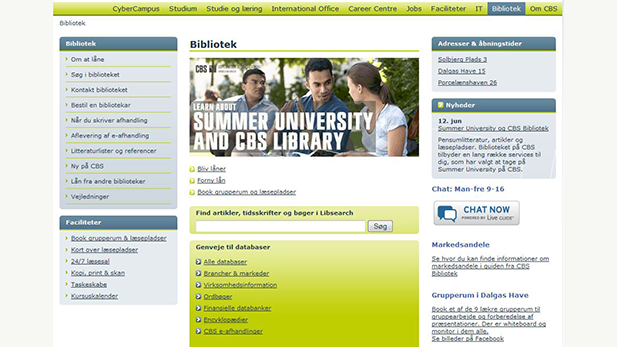
Screen shot from the library section of E-campus.
A brand new and completely redesigned website is launched in June 2004, which is a much-needed improvement on the old one. With the new website, usability-tests involving professionel assistance from external partners are introduced for the first time.
One of the main purposes of the new website is to provide hub-like access for different categories of users and to reduce duplicate information, which is why the website is accompanied by intranets for students and staff.
The CBS website assumes an increasingly prominent role in the showcasing of CBS to the outside world and website usage is now being measured for the first time. CBS is awarded “Bedst på nettet” on multiple occasions, which is an assessment of public sector domains conducted by the National Telecom Agency. In 2001, CBS Library launches a new interface for the online catalogue and related resources. For the first time ever, the ’Search the Library’ website now provides an overview of all library resources in one place.
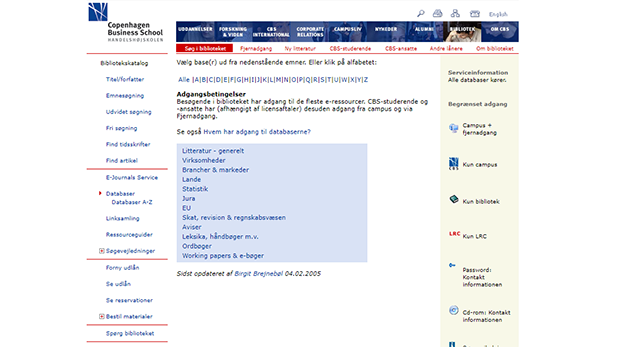
Screenshot from Wayback Machine
It becomes increasingly important to stay up to date with the latest developments in technology, which is why the library in 2003 launches KEPT (Office for Electronic Publications and Access). This office is tasked with creating an electronic archive, OpenArchives@CBS, for CBS publications, including working papers, research papers, and other documents. In general, the library is very much preoccupied with developing research services and disseminating research.
In 2007, a new platform, PURE, is introduced to register research. A new initiative, Insights @ CBS, for research communication is also launched at this time. In Insights @ CBS, readers can find articles on current CBS research. Also launched in 2007 is ResearchHub, the purpose of which is to provide information about application deadlines for research funds, among other things. This service is discontinued at the beginning of the 2010s due to the availability of other platforms for communication.
The library is also responsible for Experts @ CBS, which is a catalogue of CBS researchers and their fields of expertise where journalists and others can identify relevant experts without too much hassle. In 2003, 156 researchers are registered. The database still exists and currently holds information about almost 400 experts.
The CBS centenary book CBS gennem 100 år explains how the library played a major role in the development of the school, both as a place where faculty and students can access relevant content and as an important vehicle in the improvement of quality of CBS research through the cataloguing of CBS publications and the compiling of research development reports.
New library system twice over and the triumph of digital content
The library implements a new library system twice in the 00s. DDE-Libra, which in the 1980s was renamed Hermes at CBS, is outdated at this point as it is a DOS-based system and is no longer developed. The library wants to offer a modern system with a user interface that is easy to navigate for users when accessing digital content. The answer is Book-It from Swedish Axiell. Unfortunately, Book-It does not live up to expectations, so it is decided to switch again, this time to Aleph from Israeli ExLibris, which is in use until 2021, when, during the COVID-19 lockdowns, the current system ALMA is implemented.
The IT landscape changes rapidly at this time and now the library does not only provide access to digital content via the library catalogue but also off-campus with the implementation of a so-called proxy server. This means that faculty and students can now access contents from home as long as they make sure to sign in.
Lending of print materials plummets, which is an obvious consequence of an increased number of digital alternatives. Many users find it natural to use the digital services only and in this way escape any restrictions in terms of time and place.
The portfolio of databases increases dramatically at this time and downloading rates run high like never before. New acquisitions include World Advertising Research Centre (WARC) and EIU Country reports, both of which are still with us today.
The list of databases, which is available from the library website, is the primary point of reference in terms of communicating new acquisitions, whether database, e-journals, or other digital resources. As the list keeps growing at high pace, it becomes increasingly difficult to stay on top of individual resources.
In 2008, CBS Library provides access to 84 databases of which the Gyldendal dictionary is the most popular with 28.346 logins and 238.617 look-ups. This decade also sees a big hike in the number of e-books on offer. The library signs up with Wiley, Emerald, and Springer, which remain important e-content providers to this day.
Further readings
CBS Library celebrates 100 years (about the beginnings and the 1920s)
CBS Library in the 1930s
CBS Library in the 1940s
CBS Library in the 1950s
CBS Library in the 1960s
CBS Library in the 1970s
CBS Library in the 1980s
CBS Library in the 1990s
Resources used for this article:
Annual report Copenhagen Business School. (2000-2009). Annual Report Copenhagen Business School.
Læring på tværs af grænser - CBS bibliotek kigger langt ud Danmarks grænser med en række internationale initiativer, projekter og kontakter (2008) CBS årsberetning, (2007/2008), 31
Davidsen, L. (2006). CBS’ nye afdeling i Porcelænshaven: Bibliotek uden bøger. Bibliotekspressen, 20-23
Interne årsberetninger fra bibliotekets afdelinger 2001-2009 Jacobsen, K., & Ravn Sørensen, A. (2017). CBS gennem 100 år.(1. udgave. 1. oplag.). Historika.
Lerche, A. (2010). Når biblioteket ikke længere er et bibliotek. Bibliotekspressen, (10), 10-11
Conversations with CBS Library staff